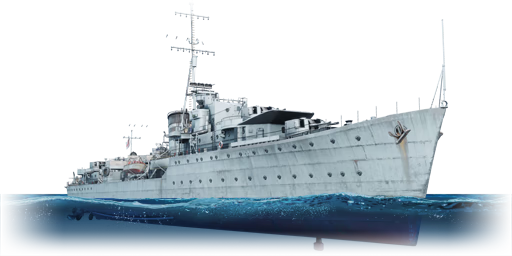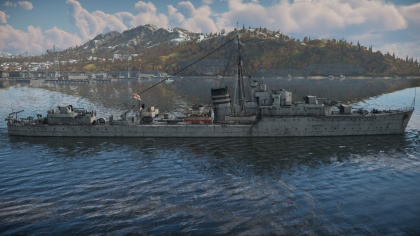Difference between revisions of "HMAS Nepal"
(→History) |
m (→History) |
||
| Line 65: | Line 65: | ||
In the postwar years, HMS Nepal underwent repairs and modifications, briefly serving as a minesweeper and training ship. In the early 1950s, HMS Nepal was part of the reserve and awaiting some proposed upgrades. However, those upgrades were eventually cancelled and the decision was made to scrap the ship. January 1956 marked the end of HMS Nepal’s 14-year service life as she was sold off for scraps to the British Iron & Steel Corporation. | In the postwar years, HMS Nepal underwent repairs and modifications, briefly serving as a minesweeper and training ship. In the early 1950s, HMS Nepal was part of the reserve and awaiting some proposed upgrades. However, those upgrades were eventually cancelled and the decision was made to scrap the ship. January 1956 marked the end of HMS Nepal’s 14-year service life as she was sold off for scraps to the British Iron & Steel Corporation. | ||
| − | |||
''- From [https://warthunder.com/en/news/5814-fleet-development-hmas-nepal-g25-air-raid-survivor-en Devblog]'' | ''- From [https://warthunder.com/en/news/5814-fleet-development-hmas-nepal-g25-air-raid-survivor-en Devblog]'' | ||
Revision as of 08:10, 8 March 2019
Contents
Description
The N-class, HMAS Nepal (G25), 1942 is a rank British destroyer
with a battle rating of (AB), (RB), and (SB). It was introduced in Update 1.83 "Masters of the Sea" as part of the British fleet closed beta test.
General info
Survivability and armour
Talk about the vehicle's armour. Note the most well-defended and most vulnerable zones, e.g. the ammo magazine. Evaluate the composition of components and assemblies responsible for movement and manoeuvrability. Evaluate the survivability of the primary and secondary armament separately. Don't forget to mention the size of the crew, which plays an important role in fleet mechanics. Tips for preserving survivability should be saved for the "Use in battle" section.
If necessary, use a graphic template to show the most well-protected or most vulnerable points in the armour.
Mobility
Write about the ship’s mobility. Evaluate its power and manoeuvrability, rudder rerouting speed, stopping speed at full tilt, with its maximum forward speed and reverse speed.
Armament
Primary armament
Provide information about the characteristics of the primary armament. Evaluate their efficacy in battle based on their reload speed, ballistics and the capacity of their shells. Add a link to the main article about the weapon: {{main|Weapon name (calibre)}}.
Broadly describe the ammunition available for the primary armament, and provide recommendations on how to use it and which ammunition to choose.
Secondary armament
Some ships are fitted with weapons of various calibers. Secondary armament is defined by the weapon chosen with the control Select secondary weapon. Evaluate the secondary armament and give advice on how to use them. Describe the ammunition available for the secondary armament. Provide recommendations on how to use them and which ammunition to choose. Remember that anti-air armament, even heavy caliber weapons, belong in the next section.
If there is no secondary armament, remove this section.
Anti-aircraft armament
An important part of the ship’s armament responsible for air raid defense. Anti-aircraft armament is defined by the weapon chosen with the control Select anti-aircraft weapons. Talk about the ship’s anti-air cannons and machine guns, the number of guns and their positions, their effective range, and about their overall effectiveness – including against surface targets.
If there is no anti-aircraft artillery, remove this section.
Torpedo armament
Many ships are armed with torpedo launchers, and for some vessels such as boats, torpedoes are an extremely important means of defeating an opponent. Evaluate the position of the torpedo launchers, discuss the ammunition available, firing specifics such as dead zones, features of the torpedoes themselves, etc.
If there is no torpedo armament, remove this section.
Special armament
Depth charges, mines, rocket launchers and missiles are also effective in skilled hands and can be an unexpected surprise for an opponent. Evaluate the ammunition of this type of armament and rate its performance in combat.
Usage in battles
Describe the technique of using this ship, the characteristics of her use in a team and tips on strategy. Abstain from writing an entire guide – don’t get try to provide a single point of view, but give the reader food for thought. Talk about the most dangerous opponents for this vehicle and provide recommendations on fighting them. If necessary, note the specifics of playing with this vehicle in various modes (AB, RB, SB).
Pros and cons
Summarize and briefly evaluate the vehicle in terms of its characteristics and combat effectiveness. Mark its pros and cons in the bulleted list. Try not to use more than 6 points for each of the characteristics. Avoid using categorical definitions such as "bad", "good" and the like - they have a substitution in the form of softer "inadequate", "effective".
Pros:
Cons:
History
HMAS Nepal was laid down in Great Britain in September of 1939, initially under the name of “Norseman”. As one of the last ships of the N-class destroyer type, she was launched in December 1941, but was soon severely damaged while still in the shipyard during a German air raid.
Despite the severe damage, the ship was repaired and renamed to Nepal, in recognition of Nepal’s contribution to the British war effort. After the repairs were completed, the ship was formally commissioned into service with the Royal Australian Navy in May 1942, although still remaining the property of the Royal Navy.
In July 1942, HMAS Nepal was assigned to the British Eastern Fleet and shortly afterwards set out for Kenya. In September, HMAS Nepal was involved in the Madagascar campaign. Before heading to Australia for refits in spring 1943, the ship served as a convoy escort and performed anti-submarine patrols.
After her two-month long refit, HMAS Nepal resumed operations in June 1943, taking part in some major operations in 1944 as a carrier escort. The ship underwent another refit in August 1944, before embarking on some of her final operations.
HMAS Nepal remained active in the Pacific theatre until the end of WW2, until being decommissioned from RNA service in October 1945. The ship was commissioned once more into the Royal Navy shortly after, being ordered to return to Britain.
In the postwar years, HMS Nepal underwent repairs and modifications, briefly serving as a minesweeper and training ship. In the early 1950s, HMS Nepal was part of the reserve and awaiting some proposed upgrades. However, those upgrades were eventually cancelled and the decision was made to scrap the ship. January 1956 marked the end of HMS Nepal’s 14-year service life as she was sold off for scraps to the British Iron & Steel Corporation.
- From Devblog
Media
An excellent addition to the article will be video guides, as well as screenshots from the game and photos.
See also
Links to the articles on the War Thunder Wiki that you think will be useful for the reader, for example:
- reference to the series of the ship;
- links to approximate analogues of other nations and research trees.
External links
| Britain destroyers | |
|---|---|
| Town-class | HMS Churchill · HMS Montgomery |
| V-class | HMS Valhalla · HMS Vega · HMS Verdun |
| G-class | HMS Grafton · ORP Garland |
| Hunt-class | HMS Calpe · HMS Brissenden |
| Tribal-class | HMCS Haida · HMS Eskimo · HMS Mohawk |
| J-class | HMS Jervis |
| K-class | HMS Kelvin |
| N-class | HMAS Nepal |
| Battle-class | HMS Armada · HMS Cadiz · HMAS Tobruk |
| Daring-class | HMS Daring · HMS Diamond · HMS Diana |





